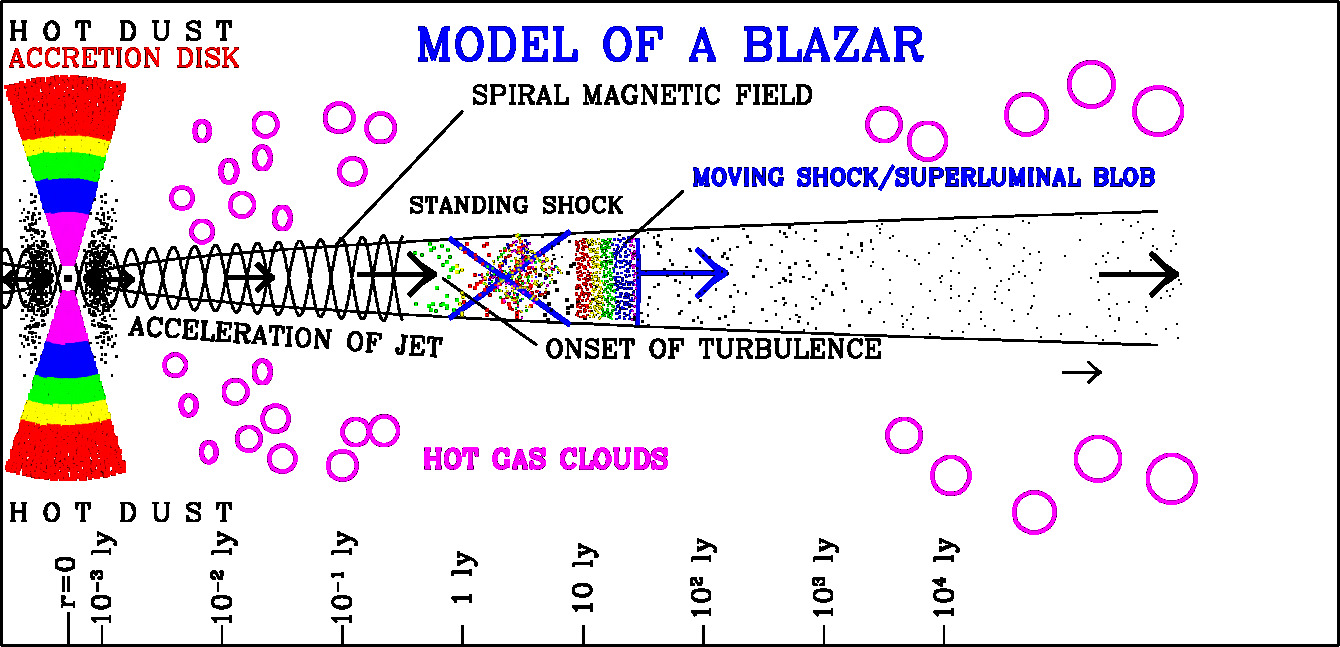Fermi 10 Blog
for "Fermi Fridays" Series: Behind the Scenes:
Doing Science Across the Spectrum (author's version)
-
Posted on
3/16/2018 at https://fermi.gsfc.nasa.gov/ssc/
Professor
Alan Marscher,
Institute for Astrophysical Research, Boston University
The gamma-ray
sky seen by Fermi is lit up by blazars, the most extreme examples of
super-massive black holes
swallowing gas at the centers of large galaxies. A tiny fraction of the
charged
particles near the black hole are funneled by magnetic forces into
narrow jets
that are propelled outward at 0.98-0.999 times the speed of light.
Despite the
low density of particles in the jets, the electrons gain so much energy
that
they produce gamma rays with a luminosity higher than that of any other
object
in the universe that shines for more than a few minutes. (Only the
short-lived
gamma-ray bursts produce more energy.)

Artist's
concept
of an Active Galactic Nucleus (AGN) with a jet. Blazars
are those AGN for which the jet
is pointed toward Earth.
Credit:
NASA/Goddard Space Flight Center Conceptual Image
Lab.
Astronomers can also measure the polarization of the light at visible and radio wavelengths. For light produced by high-energy electrons moving along magnetic fields, the degree of polarization tells us whether the field is well-ordered (high percentage of polarization) or in disarray, as occurs if there is a lot of turbulence in the jet. The direction of the polarization gives us the average direction of the magnetic field. In some blazars, we see the polarization direction rotate with time, which suggests that the magnetic field has a spiral shape, just as predicted by theories for producing jets when magnetic fields are twisted by rotation of the black hole.
gamma-ray, X-ray, and visible wave-
lengths in the blazar 3C 454.3. The
second panel from the bottom displays
the degree of polarization of the
visible light, while the bottom panel
shows the direction of the
polarization,
which is perpendicular to the average
direction of the magnetic field in the
blazar's jet. Note that the direction
of
the polarization often changes
rapidly,
as if it is rotating.


The movie on
the left, created by Dr. S. Jorstad, shows hows the jet in
the blazar 4C 21.35 has changed with time. Blobs that seem to move
faster than light appear. The figure to the right displays changes of
brightness and polarization with time; times when a new superluminal
blob appeared are indicated by the this vertical red lines.
Interpretation of the observations
requires the development of theoretical models based on gravity,
orbits, and
our knowledge of how particles and magnetic fields behave. The
polarization
levels, which are rarely more than 30%, indicate that turbulence
scrambles the
magnetic field into a spaghetti-like pattern. But there is partial
order to the
field as well, which can be explained if it is both twisted by rotation
and
compressed by shock waves. Both turbulence and shock waves are known to
energize charged particles like the electrons that make the light at
the various
wavelengths in blazars. It’s probably the case that everything that can
happen
in such a high-energy situation does happen. The cartoon below sketches
the
various phenomena that we think occur in a blazar.

Sketch of the
complex processes in a blazar. The gamma rays
may come from the zone where the jet accelerates to near-light speed,
turbulent
regions, a standing shock, or a moving shock, or all of these. The
photons that
electrons in the jet knock up to X-ray and gamma-ray energies can come
from the
accretion disk, hot dust in the outer disk, hot gas clouds, or the jet
itself.
The scale in light years, shown on the bottom, increases by ten times
with each
tick mark so that everything will fit in the sketch. [© 2018 by A. Marscher]